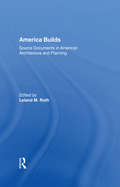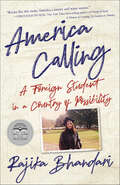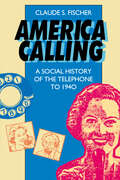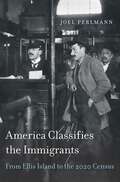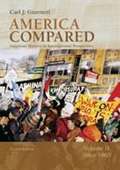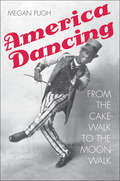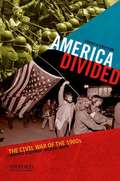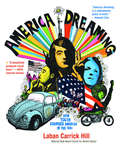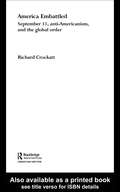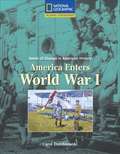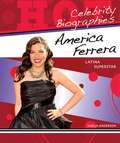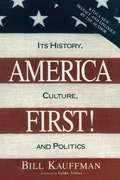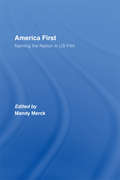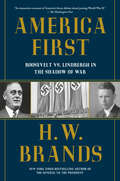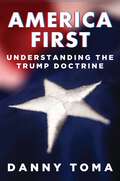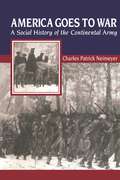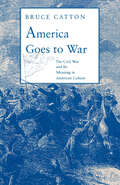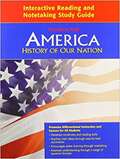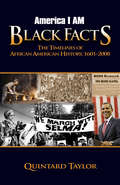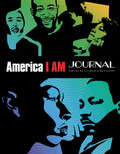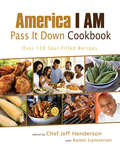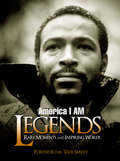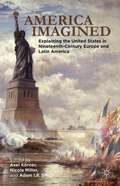- Table View
- List View
America Builds: Source Documents in American Architecture and Planning (Icon Editions Ser.)
by Leland M. RothArchitecture requires a broad definition. It involves more than simply questions of style, esoteric theory, or technical progress; it is the physical record of a culture's relationship to its technology and the land, and, most important, of the system of values concerning men's relationships with one another. Hence this volume, like my Concise Hist
America Calling: A Foreign Student in a Country of Possibility
by Rajika BhandariGrowing up in middle-class India, Rajika Bhandari has seen generations of her family look westward, where an American education means status and success. But she resists the lure of America because those who left never return—they all become flies trapped in honey in a land of opportunity. As a young woman, however, she finds herself heading to a US university to study, following her heart and a relationship. When that relationship ends and she fails in her attempt to move back to India as a foreign-educated woman, she returns to the US and finds herself in a job where the personal is political and professional: she is immersed in the lives of international students who come to America from over 200 countries, the universities that attract them, and the tangled web of immigration that a student must navigate. An unflinching and insightful narrative that explores the global appeal of a Made in America education that is a bridge to America’s successful past and to its future, America Calling is both a deeply personal story of Bhandari’s search for her place and voice, and an incisive analysis of America’s relationship with the rest of the world through the most powerful tool of diplomacy: education. At a time of growing nationalism, a turning inward, and fear of the “other,” America Calling is ultimately a call to action to keep America’s borders—and minds—open.
America Calling: A Social History of the Telephone to 1940
by Claude S. FischerThe telephone looms large in our lives, as ever present in modern societies as cars and television. Claude Fischer presents the first social history of this vital but little-studied technology—how we encountered, tested, and ultimately embraced it with enthusiasm. Using telephone ads, oral histories, telephone industry correspondence, and statistical data, Fischer's work is a colorful exploration of how, when, and why Americans started communicating in this radically new manner.Studying three California communities, Fischer uncovers how the telephone became integrated into the private worlds and community activities of average Americans in the first decades of this century. Women were especially avid in their use, a phenomenon which the industry first vigorously discouraged and then later wholeheartedly promoted. Again and again Fischer finds that the telephone supported a wide-ranging network of social relations and played a crucial role in community life, especially for women, from organizing children's relationships and church activities to alleviating the loneliness and boredom of rural life.Deftly written and meticulously researched, America Calling adds an important new chapter to the social history of our nation and illuminates a fundamental aspect of cultural modernism that is integral to contemporary life.
America Classifies the Immigrants: From Ellis Island to the 2020 Census
by Joel PerlmannWhen more than twenty million immigrants arrived in the United States between 1880 and 1920, the government attempted to classify them according to prevailing ideas about race and nationality. But this proved hard to do. Ideas about racial or national difference were slippery, contested, and yet consequential—were “Hebrews” a “race,” a “religion,” or a “people”? As Joel Perlmann shows, a self-appointed pair of officials created the government’s 1897 List of Races and Peoples, which shaped exclusionary immigration laws, the wording of the U.S. Census, and federal studies that informed social policy. Its categories served to maintain old divisions and establish new ones. <P><P> Across the five decades ending in the 1920s, American immigration policy built increasingly upon the belief that some groups of immigrants were desirable, others not. Perlmann traces how the debates over this policy institutionalized race distinctions—between whites and nonwhites, but also among whites—in immigration laws that lasted four decades. <P><P> Despite a gradual shift among social scientists from “race” to “ethnic group” after the 1920s, the diffusion of this key concept among government officials and the public remained limited until the end of the 1960s. Taking up dramatic changes to racial and ethnic classification since then, America Classifies the Immigrants concentrates on three crucial reforms to the American Census: the introduction of Hispanic origin and ancestry (1980), the recognition of mixed racial origins (2000), and a rethinking of the connections between race and ethnic group (proposed for 2020).
America Compared: Since 1865 (Second Edition)
by Carl J. GuarneriIdeal for instructors seeking to present U. S. history in a global context, this innovative reader pairs comparative readings on key issues such as slavery, immigration, imperialism, civil rights, and western expansion. Introductions to the selections provide historical context for the issue at hand, background information on the countries being compared, and discussion of ideas or arguments contained in the selections.
America Dancing
by Megan PughThe history of American dance reflects the nation's tangled culture. Dancers from wildly different backgrounds learned, imitated, and stole from one another. Audiences everywhere embraced the result as deeply American. Using the stories of tapper Bill "Bojangles" Robinson, Ginger Rogers and Fred Astaire, ballet and Broadway choreographer Agnes de Mille, choreographer Paul Taylor, and Michael Jackson, Megan Pugh shows how freedom--that nebulous, contested American ideal--emerges as a genre-defining aesthetic. In Pugh's account, ballerinas mingle with slumming thrill-seekers, and hoedowns show up on elite opera house stages. Steps invented by slaves on antebellum plantations captivate the British royalty and the Parisian avant-garde. Dances were better boundary crossers than their dancers, however, and the issues of race and class that haunt everyday life shadow American dance as well. Deftly narrated, America Dancing demonstrates the centrality of dance in American art, life, and identity, taking us to watershed moments when the nation worked out a sense of itself through public movement.
America Divided: The Civil War of the 1960s
by Michael Kazin Maurice IssermanAmerica Divided: The Civil War of the 1960s, Fourth Edition, is the definitive interpretive survey of the political, social, and cultural history of 1960s America. Written by two top experts on the era-Maurice Isserman, a scholar of the Left, and Michael Kazin, a specialist in Right-wing politics and culture-this book provides a compelling tale of this tumultuous era filled with fresh and persuasive insights. For the fourth edition the authors have updated the text in light of new research, offering strong and thoughtful analysis of such key topics as the U. S. entry into the Vietnam War, youth culture, the New Left, and women and minority groups. Presenting the most even-handed overview of this turbulent period, America Divided, Fourth Edition, defines, discusses, and analyzes all sides of the political, social, and cultural conflicts of the 1960s in a swiftly moving narrative. It is ideal for courses in 1960s America and America since 1945, or for anyone interested in the last fifty years of American History.
America Dreaming: How Youth Changed America in the Sixties
by Laban Carrick HillLaban Hill, author of the acclaimed Harlem Stomp, is back with an in-depth exploration of America in the 1960's and the young people who built a new world around them and changed our society significantly. Like Harlem Stomp, America Dreaming is an educational and visual look into a time of energy and influence. Covering subjects such as the civil rights movement, hippie culture, black nationalism, and the feminist movement, Hill paints a sprawling picture of life in the '60's and shows how teenagers were on the forefront of the societal changes that occurred during this grand decade. America Dreaming is a virtual time capsule, full of photos, song lyrics, poetry, art, protest posters, sixties lingo and iconography that will give readers an authentic and inspiring experience.
America Embattled: September 11, Anti-americanism, And The Global Order
by Richard CrockattWhat causes Anti- Americanism and where are its historical roots? What is the impact of 9/11 on America's sense of itself and its role in the world? Is America paradoxically a victim of its own political and economic power? This book seeks to understand the terrible attacks of September 11th within a broader historical, political and ideological context. Rather than drawing on simple 'clash of civilisation' oppositions, the author argues that it is important to have an awareness of the complex historical processes which influence: America's sense of itself and its changing view of the world How the world, especially the Muslim world, views America The changing nature of international politics and the global system since the end of the cold war. Drawing on a wide range of contemporary and historical sources Richard Crockatt has written a balanced, subtle and highly readable book which provides genuine insight into American foreign policy, anti-Americanism and Islamic fundamentalism. It will be important reading for all those seeking to understand the background to the 'war on terror'.
America Enters World War I
by Carol DomblewskiThe book talks about the World War I's two main alliances,how nations began to build strong armies,navies, to train soldiers , make weapons and how America entered the war.
America Fascism and God
by Davidson LoehrReligion and politics have always been a potent mix. History is littered with times when that combination caused sweeping death and destruction, when it fueled aggression and oppression-and when it gave fascism a religious and diplomatic face. Reverend Davidson Loehr is afraid that we may be living in such a time in America today. On the Sunday following the election on November 2, 2004, Loehr, a liberal minister in Texas, delivered a sermon titled "Living Under Fascism"-a sermon that spread like wildfire through the Internet. "I mean to persuade you that the style of governing into which America has slid is most accurately described as fascism, and that the necessary implications of this fact are rightly regarded as terrifying," the preacher told his congregation. ". . . and even if I don't persuade you, I hope to raise the level of your thinking about who and where we are now. " In this series of incisive and inspired sermons, Loehr takes aim at the unholy alliance of corporate money, political power, and religious fundamentalism that is threatening both our political and our economic democracy. But Loehr's words provide little comfort to liberals and progressives who have stubbornly clung to a radical individualism and an amoral secularism. "America, Fascism, and God" is a call-first to understand that religion has been hijacked and debased. And then to take it back.
America Ferrera: Latina Superstar
by Sheila AndersonAmerica Ferrera may play Ugly Betty on TV, but she's anything but ugly in real life! Down to earth, determined, and proud of her accomplishments, Ferrera has become a role model for Latina women everywhere. This fun-to-read book offers juicy quotes, personal stories, and accessible features such as a timeline and glossary.
America First!: Its History, Culture, and Politics
by Gore Vidal Bill KauffmanThis lively, iconoclastic book, first published in 1995, but enduringly relevant, explores the rich heritage, the turbulent present, and the possible future of the political and cultural tendency known as "America First." With its isolationist stance against foreign wars and economic globalism, America First has helped to shape, if only in opposition, American policy both at home and abroad. Bill Kauffman, a columnist for The American Conservative, examines the nineteenth-century underpinnings and twentieth-century eruptions of American isolationism and nationalism, which are the fault lines along which the politics of the 21st century are cleaving. Kauffman recounts a fascinating story of "Little American" political culture, which was distinguished by its opposition to militarism, big government, and the concentration of wealth in the hands of the few, and by its promotion of the common man. The populist-isolationist song continues to be sung by many ordinary Americans who are far from the corridors of power yet who decry passionately, even desperately, what they consider reckless and destructive foreign wars and economic and immigration policies.In a new preface and epilogue written especially for this reissue, Kauffman traces the evolution of America First sentiment over the past twenty years: from its near-eclipse in the war hysteria of the George W. Bush administration to its revival in 2016 with the populist campaigns of Donald Trump and Senator Bernie Sanders.America First! is a rarity among political books: it remains more timely, relevant, and even urgent than ever.From the Trade Paperback edition.
America First: Naming the Nation in US Film
by Mandy MerckAt a time when the expanded projection of US political, military, economic and cultural power draws intensified global concern, understanding how that country understands itself seems more important than ever. This collection of new critical essays tackles this old problem in a new way, by examining some of the hundreds of US films that announce themselves as titularly 'American'. From early travelogues to contemporary comedies, national nomination has been an abiding characteristic of American motion pictures, heading the work of Porter, Guy-Blaché, DeMille, Capra, Sternberg, Vidor, Minnelli and Mankiewicz. More recently, George Lucas, Paul Schrader, John Landis and Edward James Olmos have made their own contributions to Hollywood’s Americana. What does this national branding signify? Which versions of Americanism are valorized, and which marginalized or excluded? Out of which social and historical contexts do they emerge, and for and by whom are they constructed? Edited by Mandy Merck, the collection contains detailed analyses of such films as The Vanishing American, American Madness, An American in Paris, American Graffiti, American Gigolo, American Pie and many more.
America First: Roosevelt vs. Lindbergh in the Shadow of War
by H. W. BrandsBestselling historian and Pulitzer Prize finalist H. W. Brands narrates the fierce debate over America's role in the world in the runup to World War II through its two most important figures: President Franklin D. Roosevelt, who advocated intervention, and his isolationist nemesis, aviator and popular hero Charles Lindbergh.Hitler's invasion of Poland in September 1939 launched a momentous period of decision-making for the United States. With fascism rampant abroad, should America take responsibility for its defeat?For popular hero Charles Lindbergh, saying no to another world war only twenty years after the first was the obvious answer. Lindbergh had become famous and adored around the world after his historic first flight over the Atlantic in 1927. In the years since, he had emerged as a vocal critic of American involvement overseas, rallying Americans against foreign war as the leading spokesman the America First Committee. While Hitler advanced across Europe and threatened the British Isles, President Franklin Delano Roosevelt struggled to turn the tide of public opinion. With great effort, political shrewdness and outright deception—aided by secret British disinformation efforts in America—FDR readied the country for war. He pushed the US onto the world stage where it has stayed ever since.In this gripping narrative, H.W. Brands sheds light on a crucial tipping point in American history and depicts the making of a legendary president.
America First: Understanding the Trump Doctrine
by Danny TomaDonald Trump, Statesman? Critics dismissed the idea out of hand. Even his fans questioned whether President Trump could do what other presidents had considered impossible. But in less than two years, Trump has: - Put North Korea on the path to de-nuclearization and peace with South Korea. - Destroyed the "state" of the Islamic State. - Forged a de facto alliance between Saudi Arabia and Israel. - Doled out real punishment - not empty threats - for Syria's use of chemical weapons. -Re-negotiated international trade deals on terms more favorable to the United States. President Donald Trump's foreign policy successes have stunned not just his critics, but the world. Now Danny Toma, a State Department veteran, explains how Trump has done it, what the Trump Doctrine entails, and how it can- and likely will - continue to succeed. As Toma demonstrates, President Trump has restored American foreign policy to its traditional moorings, which anchored such "realist" presidents as George Washington, Dwight Eisenhower, and Ronald Reagan, who put American interests first, avoided unnecessary foreign entanglements, and pursued peace through strength. That foreign policy tradition made America great and, under President Trump's leadership, is making America great again. When America has strayed from those principles - especially as witnessed in the foreign policies of such "idealist" presidents as Jimmy Carter, Bill Clinton, George W. Bush, and Barak Obama - the results have been expensive in lives, treasure, and even international retreat. Provacative, thorough, and engagingly written, Danny Toma's America First is the one book you need to understand how America can again lead the world and protect her own interests.
America Goes to War: A Social History of the Continental Army (The American Social Experience #26)
by Charles Patrick NeimeyerA unique and revealing analysis of the diverse body that made up the Continental Army during the American Revolutionary War.One of the images Americans hold most dear is that of the drum-beating, fire-eating Yankee Doodle Dandy rebel, overpowering his British adversaries through sheer grit and determination. The myth of the classless, independence-minded farmer or hard-working artisan-turned-soldier is deeply ingrained in the national psyche.Charles Neimeyer here separates fact from fiction, revealing for the first time who really served in the army during the Revolution and why. His conclusions are startling. Because the army relied primarily on those not connected to the new American aristocracy, the African Americans, Irish, Germans, Native Americans, laborers-for-hire, and “free white men on the move” who served in the army were only rarely altruistic patriots driven by a vision of liberty and national unity.Bringing to light the true composition of the enlisted ranks, the relationships of African-Americans and of Native Americans to the army, and numerous acts of mutiny, desertion, and resistance against officers and government, Charles Patrick Neimeyer here provides the first comprehensive and historically accurate portrait of the Continental soldier.
America Goes to War: The Civil War and Its Meaning in American Culture
by Bruce CattonA fascinating study of the first modern war and its effect on American Culture.
America Goes to the Fair: All about State and County Fairs in the United States
by Lila PerlCommercial fairs come in all sizes-- county, state, and international--and they are as popular today as ever. How did they come to be? What goes on at them? Why do they continue to appeal to young people? This lively report on the modern fair answers these questions and many others. The opening chapters relate the change from the European market fair, like the one at Nizhni Novgorod in Russia, to the competitive showcase that developed in the United States. Following chapters take up the various activities that fairs engage in: agricultural events, household arts, youth and vocational programs, entertainment, and special exhibits in such fields as science and transportation. Specific examples from the over 3200 fairs that take place each year illustrate each category, and major fairs all over the country are included. Not surprisingly, the largest one is the State Fair of Texas, held outside of Dallas. All this wide-ranging information is gathered together in a smoothly knit narrative by a knowledgeable author, who has participated in a number of fairs herself.
America History of Our Nation: Interactive Reading And Note Taking Study Guide [on-level]
by Prentice-Hall StaffThis edition was developed specifically for courses covering up to the Civil War or Reconstruction. The text can also be used for the first part of a two-year American history course.
America I AM BlACK FACTS: The Timelines Of African American History, 1601-2008
by Quintard TaylorThis invaluable reference timeline charts African American history from 1601-2008 against the backdrop of American and world history. AIA Black Facts reveals the unexpected relationships between people and events, and the often unrecognized causes and effects that created African Americans’ indelible imprint on our nation.
America I AM Journal
by Clarence ReynoldsWhat will you leave behind? It's time to discover the unique and indelible life imprint that only you can create. Filled with inspiring quotations from those who have made a lasting impression on our culture and left a rich legacy, the AIA Journal will encourage you to reflect on what makes your life worth living. Record the positive imprints of your life's journey, every day, in this beautiful journal inspired by the AIA exhibit.
America I AM Pass It Down Cookbook: Over 130 Soul-filled Recipes
by Jeff HendersonThe smells in the kitchen, the unforgettable flavors-these powerful memories of food, family, and tradition are intertwined and have traveled down from generations past to help make us the people we are today. Now, Tavis Smiley's America I AM exhibit has joined forces with Chef Jeff Henderson and Ramin Ganeshram to create the America I AM Pass It Down Cookbook. This special keepsake preserves African Americans' collective food history through touching essays, celebratory menus, and over 130 soul-filled and soul-inspired recipes. There's something for everyone-from traditional southern cooking like Apryle's Seafood Gumbo, Craig Robinson's Mom's Buttermilk Fried Chicken, and Russel Honoré's Barbecued Boston Pork Butt, to healthy new millennium twists, including the Duo Dishes' Honey Dijon Spiced Pecan Coleslaw, Ron Johnson's Crunchy Collards, and Scott Alves Barton's Fragrant Jerk Chicken. Irresistible desserts like Mama Mabel's Apple Dumplings and Saporous Strawberry Cheesecake, and beverages like Very Exciting Fruit Punch and Tom Bullock's classic Lemonade Apollinaris are sure to delight. As you read this book, you'll discover the voices of real cooks and their triumphs in the kitchen, and the ways in which African Americans have impacted the way the whole nation eats. You'll learn healthy cooking variations filled with heart and soul, and how to make cooking with kids fun. There's even a section for you to add your own family recipes and "pass it down" to the next generation. It's time to turn the pages and join us at the table. After all, our shared experience is the greatest feast of all. Be the first to review this product! EBOOK EDITIONS Amazon Kindle Store iTunes iBookstore Share this product with friends
America I am legends: Rare Moments And Inspiring Words
by Tavis SmileyWould America have been America without her Negro people?" - W. E. B. Du Bois America I AM: The African American Imprint, a national traveling museum exhibition, was conceived by award-winning broadcaster and bestselling author Tavis Smiley as a one-of-a-kind multi-media experience that chronicles the distinct history of African Americans. This beautifully conceived companion volume addresses the central theme of the exhibition, posed by W. E. B. Du Bois: "Would America have been America without her Negro people?" Through exceptional photographic images and penetrating words, America I AM Legends captures the dynamism of 78 legendary African Americans, highlighting the indelible imprint each has made on the United States and the world. A statement illuminating a unique aspect of each iconic figure- made by the legend or by someone carrying on their legacy today-portrays the vision and contribution of each subject. Whether black artistic genius, athletic excellence, political leadership, or the struggle to hold America true to its promise, each legend reminds us that America would be unrecognizable without its African American imprint. America I AM Legends takes us on an unforgettable journey to the heart of the American experience.
America Imagined
by Axel K�rner Nicola Miller Adam I. P. SmithThis is an exploration of how Latin America developed an alternative modernity during the early twentieth century, one that challenges the key assumptions of the Western dominant model.
